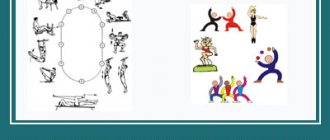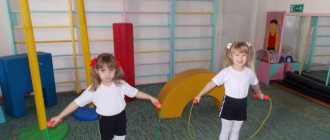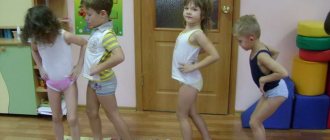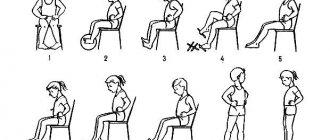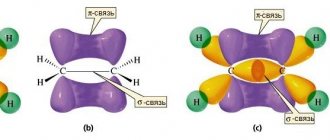Outdoor switchgear complex for children 4-5 years old
Outdoor switchgear complexes for children 4-5 years old
September
Complex 1
1. Walking and running in a column one at a time at a signal from the teacher (the signal is musical accompaniment or beating a tambourine).
Exercises without objects
2. I. p. – stand with legs parallel, hands below. Raise your arms up to your sides, clap your hands; lower your arms to your sides, return to the starting position (4-5 times).
3. I. p. – stand with your feet shoulder-width apart, hands on your belt. Turn right (left), move your right hand to the side; straighten up, return to the starting position (3 times).
4. I. p. - stand with your feet at the width of your feet, hands on your belt. Sit down, bring your arms forward; stand up, straighten up, return to the starting position (5-6 times).
5. I. p. – stand with legs apart, hands behind your back. Lean forward, touch the floor with your fingers; straighten up, return to the starting position (4-5 times).
6. I. p. - stand with legs slightly apart, hands on the belt. Jumping on two legs on a count of 1–8; repeat 2 times with a short pause.
7. Game “Find yourself a mate.”
One group of children receives blue handkerchiefs, the other - red. At the teacher’s signal, the children scatter throughout the playground. At the signal “Find a pair!” Children who have identical scarves stand in pairs. If the number of players is odd, then the teacher plays with the children.
8. Walking in a column one at a time, waving handkerchiefs.
Complex 2
1. Walking and running in a column one at a time; walking and running randomly across the entire site.
Hoop exercises
2. I. p. - stand with legs slightly apart, hoop with a grip from the sides on the chest. 1 – hoop forward, arms straight; 2 – hoop up; 3 – hoop forward; 4 – return to the starting position (4–5 times).
3. I. p. – stand with feet shoulder-width apart, hoop below. 1 – hoop forward; 2 – bend forward, touch the floor with the hoop; 3 – straighten up, hoop forward; 4 – return to the starting position (4–5 times).
4. I. p. – stand with feet shoulder-width apart, hoop with a grip from the sides on the chest. 1–2 – turn right (left), hoop right (left); 3–4 – return to the starting position (6 times).
5. I. p. - stand in a hoop, arms along the body. Jumping on two legs in a hoop on a count of 1–8. Repeat 2 times with a short pause.
6. Game "Cars".
Each player receives a cardboard circle - this is the steering wheel. At the teacher’s signal—the green flag is raised—the children scatter all over the playground (the main thing is that they do not bump into each other). At another signal - a red flag - the cars stop.
7. Walking in a column one at a time - the cars went to the garage.
Complex 3
1. Walking in a column one at a time; running along a bridge on a board or track (width 25 cm, length 3 m).
Exercises with flags
2. I. p. – leg stand at the width of the foot, flags below. 1 – flags to the sides; 2 – flags up, sticks crossed; 3 – flags to the sides (Fig. 12); 4 – return to the starting position (4–5 times).
Rice. 12
1. I. p. – leg stand at the width of the foot, flags below. 1–2 – sit down, flags forward; 3–4 – return to the starting position (5–6 times).
2. I. p. – stand with feet shoulder-width apart, flags below. 1 – turn right (left), flags to the sides; 2 – straighten up, return to the starting position (3 times each).
3. I. p. – stand with feet shoulder-width apart, flags below. 1 – lean forward, flags to the sides; 2 – cross the flags in front of you; 3 – flags to the sides; 4 – straighten up, return to the starting position (4–5 times).
4. I. p. - stand with legs slightly apart, flags below. Jumping on two legs in place with a short pause.
5. Walking in a column one at a time, both flags in the right hand raised above the head.
Complex 4
1. Walking and running between balls (6–8 pieces) placed in one line (distance between balls 0.5 m).
Exercises with a large diameter ball
2. I. p. - stand with your feet as wide as your feet, with the ball in both hands below. 1 – bend your arms, put the ball on your chest; 2 – ball up; 3 – ball on the chest; 4 – return to the starting position (4–5 times).
3. I. p. - stand with your feet as wide as your feet, holding the ball in bent arms on your chest. 1 – sit down, bring the ball forward; 2 – get up, return to the starting position (5-6 times).
4. I. p. – stand with feet shoulder-width apart, ball in bent arms on chest. 1 – tilt towards the right leg; 2–3 – roll the ball to your left foot, pushing it with your right hand, take it in both hands; 4 – return to the starting position (4–6 times).
5. I. p. - stand with legs slightly apart, ball on the floor. Jump on two legs around the ball in both directions with a short pause.
6. Game “Find yourself a match” (using handkerchiefs of two colors).
7. Walking in a column one at a time, waving a handkerchief.
October
Complex 5
1. Walking and running around the blocks, turning in both directions at the teacher’s signal.
Exercises with cubes
2. I. p. – leg stand at the width of the foot, cubes in both hands below. 1 – cubes to the sides; 2 – cubes up; 3 – cubes to the sides; 4 – starting position (5–6 times).
3. I. p. – leg stand at the width of the foot, cubes in bent arms at the shoulders. 1 – sit down, put the cubes on the floor; 2 – stand up, hands on your belt; 3 – sit down, take the cubes; 4 – return to the starting position (4–6 times).
4. I. p. – stand with feet shoulder-width apart, cubes in bent arms at the shoulders. 1–2 – turn to the right (left), move your right hand to the side; 3–4 – return to the starting position (6 times).
5. I. p. – sitting legs apart, cubes at the shoulders. 1 – bend forward, place the cubes at the toes; 2 – straighten up, hands on your waist; 3 – bend down, take the cubes; 4 – return to the starting position (4–5 times).
6. I. p. - stand with legs slightly apart, arms at random, cubes on the floor. Jump around the cubes in both directions.
7. Walking in a column one at a time.
Complex 6
1. Walking in a column one at a time, going around objects placed at the corners of the site. Running in all directions.
Exercises with a braid (short cord)
2. I. p. – legs apart, braid at the bottom. 1 – lift the pigtail forward; 2 – up; 3 – forward; 4 – return to the starting position (5–6 times).
3. I. p. – leg stand at the width of the foot, braid at the bottom. 1 – lift the pigtail forward; 2 – sit down, arms straight; 3 – stand up, braid forward; 4 – return to the starting position (5–6 times).
4. I. p. – kneeling position, braid at the bottom. 1–2 – turn to the right (left), move the pigtail to the side, arms straight. 3–4 – return to the starting position (6 times).
5. I. p. - sitting legs apart, pigtail on knees. 1 – lift the pigtail up; 2 – lean forward, touch the pigtail to the floor as far as possible; 3 – straighten up, braid up; 4 – return to the starting position (4–5 times).
6. I. p. – stand with legs slightly apart, arms at random, braid on the floor. Jumping on two legs through a pigtail.
7. Game "Cars".
8. Walking in a column one at a time - the cars went to the garage.
Complex 7
1. Game “Cucumber, cucumber...” (jumping, easy running).
At one end of the playground (hall) there is a mouse (teacher), at the other - children. They approach the mouse by jumping on two legs, and she says:
Cucumber, cucumber,
Don't go to that end.
There's a mouse living there
He'll bite your tail off.
The children run away to their house (beyond the line), and the teacher catches up with them.
Exercises without objects
2. I. p. – stand with your feet at the width of your feet, hands in front of your chest. 1 – arms to the sides; 2 – return to the starting position.
3. I. p. – stand with your feet shoulder-width apart, hands on your belt. 1 – forward tilt; 2 – straighten up (5-6 times).
4. I. p. - stand with your feet at the width of your feet, hands on your belt. 1 – arms to the sides; 2 – sit down; 3 – straighten up, arms to the sides; 4 – starting position (5–6 times).
5. I. p. - stand with legs slightly apart, hands down. 1–2 – rising on your toes, hands behind your head, elbows to the sides; 3-4 return to the starting position (5-6 times).
6. Game "Let's find the frog."
Complex 8
1. Walking in a column one at a time, at the teacher’s signal: “Stop!” stay; running in a column one at a time. Walking and running alternate.
Hoop exercises
2. I. p. - stand with your feet as wide as your feet, with the hoop in bent arms placed on your shoulders. 1 – lift the hoop up, look into it; 2 – return to the starting position (5–6 times).
3. I. p. - stand in a hoop, legs slightly apart, hands down. 1 – sit down, grab the hoop with a side grip; 2 – straighten up, raise the hoop to waist level; 3 – sit down, put the hoop (Fig. 13); 4 – stand up, return to the starting position (4–5 times).
Rice. 13
4. I. p. - sitting, legs bent in a hoop, arms supported behind. 1 – straightening, raise both legs up; 2 – spread your legs apart, lower them to the floor on both sides of the hoop; 3 – raise straight legs up, connecting; 4 – return to the starting position (4–5 times).
5. I. p. - stand in support on the knees, hoop in bent arms on the chest. 1 – turn the body to the right (left); 2 – return to the starting position (6 times).
6. I. p. - stand in front of the hoop, legs slightly apart, arms along the body. Jump on two legs around the hoop in both directions with a short pause.
7. Game "Guess who's screaming."
November
Complex 9
1. Game exercise “Cat and Mice”.
In the center of the hall (platform) there is a driver - a cat. On one side of the hall the house of mice is marked with a line or a cord. The teacher says:
The cat guards the mice
Pretended to be asleep.
Children run easily and silently in different directions, and the teacher says:
Hush, mice, don't make noise
And don't wake the cat.
After 30 seconds, the teacher exclaims: “The cat is awake!” A child pretending to be a cat shouts: “Meow!” and runs after the mice, and they hide in holes, running over the line before the cat catches them (spits them).
Walking in a column, one at a time, on the toes, hands on the belt behind the cat - he leads the mice.
Exercises with a stick
2. I. p. – stand with your feet as wide as your feet, with a stick at the bottom with a grip wider than your shoulders. 1 – stick up, stretch; 2 – bending your arms, put the stick back on your shoulder blades; 3 – stick up; 4 – stick down, return to the starting position (4-6 times).
3. I. p. – leg stand at the width of the foot, stick below, grip at shoulder width. 1 – sit down, stick forward; 2 – starting position (5–6 times).
4. I. p. – legs apart, stick below. 1–2 – bend forward, stick up, bend over; 3–4 – starting position (5–6 times).
5. I. p. - stand with your feet shoulder-width apart, stick behind your head on your shoulders. 1 – step with the right foot to the right; 2 – tilt to the right; 3 – straighten up; 4 – starting position. The same to the left (5-6 times).
6. I. p. – stand with your legs slightly apart, stick behind your head on your shoulders. Jumping – legs apart, legs together. Perform on a count of 1–8, then take a short pause and repeat the exercise 2–3 times.
7. Walking in a column one at a time.
Complex 10
1. Walking and running around the blocks with a turn at the teacher’s signal.
Exercises with a cube
2. I. p. – leg stand at the width of the foot, cube in the right hand. 1–2 – raise your arms up through your sides, pass the cube to your left hand; 3–4 – return to the starting position (6 times).
3. I. p. – leg stand at the width of the foot, cube in the right hand. 1 – sit down, put the cube on the floor; 2 – stand up, put your hands behind your back; 3 – sit down, take the cube in your left hand; 4 – stand up, return to the starting position (4–5 times).
4. I. p. - kneeling, cube in right hand. 1 – turn right (left), place the cube at the toes; 2 – return to the starting position; 3 – turn right (left), take the cube; 4 – return to the starting position (4–5 times).
5. I. p. - sitting legs apart, cube in right hand. 1 – lean forward, place the cube at your left foot; 2 – straighten up, hands on your waist; 3 – bend over, take the cube in your left hand; 4 – straighten up. The same with the left hand (4-6 times).
6. I. p. – leg stand at the width of the foot, cube on the floor. Jumping on two legs around a cube in both directions.
7. Walking in a column one at a time, cube in the right hand. At the teacher’s signal: “Show me the cube!” in motion, lift the cube above your head.
Complex 11
1. Walking and running in a column one at a time; walking in all directions between the balls.
Exercises with a large diameter ball
2. I. p. - stand with your feet as wide as your feet, with the ball in both hands below. 1 – lift the ball to your chest; 2 – lift the ball up, arms straight; 3 – ball on the chest; 4 – starting position (5–6 times).
3. I. p. - stand with legs apart, ball in both hands below. 1 – lift the ball to your chest; 2 – tilt towards the right leg; 3 – roll the ball to the left foot; 4 – starting position (5 times).
4. I. p. – kneeling position, sitting on the heels. 1–4 – roll the ball to the right (left) around you, helping with your hands (4–6 times).
5. I. p. – lying on your back, the ball in straight hands behind your head, 1–2 – bend your legs, touch your knees with the ball; 3–4 – return to the starting position (5–6 times).
6. I. p. – legs slightly apart, hands with the ball forward. Hit the ball on the floor, catch it with both hands (5-6 throws).
7. Game “Frogs” (jumping on two legs, moving forward).
8. Game "Let's find the frog."
Complex 12
1. Walking in a column one at a time. At the teacher’s signal: “Bees!” the children start running, flapping their arms like wings and saying: “Zhu-zhu-zhu.” Walking and running alternate.
Exercises with flags
2. I. p. – leg stand at the width of the foot, flags below. 1 – flags to the sides; 2 – flags up, arms straight; 3 – flags to the sides; 4 – starting position (5–6 times).
3. I. p. – stand with feet shoulder-width apart, flags below. 1 – turn right (left), flags to the sides; 2 – return to the starting position (5–6 times).
4. I. p. – stand with feet shoulder-width apart, flags below. 1 – flags to the sides; 2 – lean forward, cross the flags; 3 – straighten up, flags to the sides; 4 – starting position (5–6 times).
5. I. p. - feet width apart, flags at the shoulders. 1–2 – sit down, bring the flags forward; 3–4 – starting position (5–6 times).
6. I. p. – legs slightly apart, flags below. Jumping on two legs for a count of 1–8, alternating with a short pause.
7. Walk in a column one at a time, waving flags above your head (both flags in your right hand).
Winter period
December
Complex 13
1. Game “Catch up with the couple”.
Children stand in two lines at a distance of 1 m from one another. At the teacher’s command: “One, two, three – run!” the first line runs away. Each child in the second line catches up with the child in the first line standing opposite him before he crosses the finish line (distance - 10 m).
Exercises with a handkerchief
2. I. p. - stand with your feet at the width of your feet, handkerchief in both hands, grab the ends from above. 1 – lift the handkerchief forward; 2 – handkerchief up; 3 – handkerchief forward; 4 – starting position (5–6 times).
3. I. p. – stand with your feet shoulder-width apart, holding a handkerchief in your right hand below. 1–2 – turn to the right, wave your handkerchief; 3–4 – starting position. Transfer the handkerchief to your left hand. The same to the left (6 times).
4. I. p. - stand with your feet as wide as your feet, holding a handkerchief in both hands, gripping the ends from above. 1–2 – sit down, bring the handkerchief forward; 3–4 – starting position (4–6 times).
5. I. p. - stand with legs apart, handkerchief at the chest, gripping the ends from above. 1–3 – bend forward, wave the handkerchief to the right (left); 4 – starting position (5–6 times).
6. I. p. – stand with your feet as wide as your feet, holding a handkerchief in your right hand. Jumping on two legs with a turn to the right and left around its axis, waving a handkerchief (with a short pause).
7. Walk in a column one at a time, waving a handkerchief above your head.
Complex 14
1. Walking in a column one at a time. At the teacher’s signal: “Snowflakes!” children stop and perform light twirling in place, then normal walking and running.
Exercises with a small ball (diameter 10–12 cm)
2. I. p. – stand with your feet shoulder-width apart, the ball in your right hand. 1 – raise your arms to the sides; 2 – hands up, transfer the ball to the left hand; 3 – arms to the sides; 4 – starting position (4–6 times).
3. I. p. – stand with legs apart, ball in right hand. 1 – lean forward; 2–3 – roll the ball from the right foot to the left, catch it with the left hand; 4 – straighten up, ball in left hand (Fig. 14). The same for the left leg (5-6 times).
4. I. p. - sitting legs crossed, ball in right hand. 1 – turn to the right, move your right hand to the side; 2 – straighten up, transfer the ball to your left hand. The same to the left (6 times).
5. I. p. - lying on your stomach, the ball in bent arms in front of you. 1 – bend over, bring the ball up and forward (Fig. 15); 2 – return to the starting position (5–6 times).
6. I. p. - feet width apart, ball in the right hand. 1 – sit down, bring the ball forward in both hands; 2 – straighten up, return to the starting position (5-6 times).
7. I. p. – legs slightly apart, ball in the right hand. Jumping on two legs in place with a short pause.
Rice. 14
Rice. 15 Complex 15
1. Game exercise “Funny snowflakes”. Walking in a column one at a time, running in all directions - the wind carries snowflakes.
Exercises without objects
2. I. p. – stand with feet as wide as your feet, hands below. 1 – hands in front; 2 – hands up; 3–4 – through the sides of the arm down (5–6 times).
3. I. p. – leg stand at the width of the foot. 1–2 – sit down, clasp your knees with your hands; 3–4 – return to the starting position (5–6 times).
4. I. p. - sitting legs apart, hands on the belt. 1 – arms to the sides; 2 – bend towards the right (left) leg, touch your toes with your fingers; 3 – straighten up, arms to the sides; 4 – starting position (6 times).
5. I. p. - lying on your back, hands behind your head. 1–2 – raise straight legs, slam your hands on your knees; 3–4 – starting position (4–5 times).
6. I. p. - legs slightly apart, hands on the belt. Jump legs apart – legs together for a count of 1–8. Repeat 2-3 times.
7. Game exercise for children's choice.
Complex 16
1. Walking and running between cubes placed in one line (the distance between objects is 0.5 m).
Exercises with cubes
2. I. p. – leg stand at the width of the foot, cubes below. 1 – lift the cubes to the sides; 2 – cubes through the sides up; 3 – lower the cubes to the sides; 4 – return to the starting position (5–6 times).
3. I. p. – stand with your feet shoulder-width apart, cubes behind your back. 1 – lean forward, put the cubes on the floor; 2 – straighten up, arms along the body; 3 – bend down, take the cubes; 4 – starting position (6 times).
4. I. p. – leg stand at the width of the foot, cubes in both hands below. 1–2 – sit down, bring the cubes forward, knock the cubes 2 times one against the other; 3–4 – return to the starting position (5–6 times).
5. I. p. – kneeling position, cubes at the shoulders. 1–2 – turn to the right (left), place the cube at the toes; 3–4 – return to the starting position (6 times).
6. I. p. - stand with legs slightly apart, cubes on the floor. Jump on two legs around the cubes in both directions with a short pause.
7. Walking in a column one at a time.
January
Complex 17
1. Walking in a circle around the cord. At the teacher’s signal: “Jump-jump!” stop and jump into the circle, out of the circle, then walk again. Walking and jumping alternate.
Exercises with a large diameter ball
2. I. p. - stand with feet shoulder-width apart, ball in both hands below. Throw the ball up (not high), catch it with both hands (5-6 times).
3. I. p. – stand with feet shoulder-width apart, ball in both hands near the chest. Throw the ball on the floor near your right foot, catch it with both hands, and straighten up. The same for the left leg (4 times each).
4. I. p. - kneeling, sitting on your heels, ball in front of you on the floor. Rolling the ball around the body to the right and left, helping with your hands.
5. I. p. - lying on your back, the ball in both hands behind your head. Turn on your stomach, ball in straight hands, turn on your back, return to the starting position (4-6 times).
6. I. p. – legs slightly apart, ball in bent arms in front of you. Jumping on two legs with a turn around its axis in both directions.
7. Walking in a column one at a time with a ball in their hands.
Complex 18
1. Walking in a column one at a time; walking and running between objects placed scattered.
Skittle exercises
2. I. p. – leg stand at the width of the foot, pin in the right hand below. 1 – arms to the sides; 2 – hands forward, transfer the pin to the left hand; 3 – arms to the sides; 4 – starting position (4–6 times).
3. I. p. - stand with feet shoulder-width apart, pin in the right hand. 1 – arms to the sides; 2 – bend forward, transfer the pin to the left hand behind the left leg; 3 – straighten up, arms to the sides; 4 – starting position (5–6 times).
4. I. p. - kneeling, pin in the right hand. 1 – turn to the right, move the pin to the side; 2 – straighten up, transfer the pin to your left hand. The same to the left (5-6 times).
5. I. p. – sitting legs apart, pins in both hands in front of you. 1 – lean forward, place the pin between the heels; 2 – straighten up, hands on your waist; 3 &ndash
An approximate set of exercises with a gymnastic stick
1. I. p. – basic stance, stick behind the head.
1. – Left leg back, stick up, bend over. 2. – Lean to the left. 3. – Straighten up, stick up. 4. – I. p. The same in the other direction. Repeat 5-6 times. 2. I. p. – legs apart, stick at the bottom with a grip at the ends. 1 – 3. – Left hand up, springy tilts to the right. 4. – I. p. The same in the other direction. Repeat 5-6 times.
3. I. p. - main stance, stick at the bottom behind. 1 – 2. – Lean forward, place the stick on the floor behind you. 3 – 4. – Straighten up. 5 – 6. Lean forward, take a stick. 7 – 8. – I. p. Repeat 7-8 times.
4. I. p. – legs apart, stick at the top. 1 – 3. – Bend back, stick in your left hand, touch the floor with the free end. 4. – I. p. Repeat 4 – 6 times.
5. I. p. - lying on your stomach, holding the stick below your back with a grip on both ends. 1 – 2. – Slowly bend over, moving the stick upward with straight arms. 3. – Hold. 4. – I. p. Repeat 4 – 6 times.
6. I. p. - lying on your back, arms forward, stick horizontally. 1 – 2. – Place your legs between your hands, the stick behind your back (stand on your shoulder blades). 3. – Hold.4. – I. p. Repeat 4 – 6 times.
7. I. p. - basic stance, stick with one end in the left hand, the other on the floor near the left foot.1. – Leaning on a stick, squat on your left leg, your right leg straight forward (“pistol”). 2. – I. p. The same on the other leg. Repeat 4 – 6 times.
8. I. p. - the main stance, the stick stands vertically and is held with hands. 1. – Release the stick and swing your left foot over it. 2. – Catch the stick – and. n. The same for the right leg. Repeat 4-6 times.
9. I. p. - squat, stick under the knees. 1 – 3. – Bending your elbows, stand up. 4. – I. p. Repeat 4 – 6 times.
10.I. p. – main stance, stick in front. 1. – Throw the stick up. 2 – 3. – Sit down, catch the stick with both hands.4. – I. p. Repeat 4 – 6 times.
11.I. p. – main stance, stick below. 1. – Jump forward over the stick.2. – Jump back over the stick into and. p.Repeat 4-6 times.
An approximate set of exercises with a gymnastic stick in pairs
1. I. p. – standing facing each other, stick at the bottom in front.1. – At the same time, swing your left leg to the side, stick up. 2.– I. p. The same on the other leg. Repeat 4 – 6 times.
2. I. p. - standing with your back to each other, stick above your head. 1. – At the same time lunge forward with your left leg. 2. – I. p. The same on the other leg. Repeat 4 – 6 times.
3. I. p. – A – legs wider than shoulders, stick on shoulder blades. Standing from behind, legs shoulder-width apart, grab the stick with arms bent at the elbows. 1 – 3. – A – bends to the left; B – lightly pressing the stick helps you bend over. 4. – I. p. Repeat 4 – 6 times.
4. I. p. - sitting with straight legs, back to each other, stick at the top. 1. – A – forward tilt; B, bending his legs, resting his feet on the floor, lies on A’s shoulders. 2. – I. p. Repeat 4 – 6 times.
5. I. p. - And lying on your stomach, a stick on your shoulder blades, pressed with your arms bent behind your head, fingers intertwined; B standing with your feet apart, leaning forward, holding a stick. 12 . – A slowly bends back, B easily pulls the stick up. 3 – 4. – A slowly descends into i. P.; B holds the stick lightly. Repeat 4-6 times.
6. I. p. - And lying on your back, a stick on your shoulder blades, pressed, fingers intertwined; B legs apart, bent over, grabbing the stick with both hands. 1 – 2. – B pulls the stick up and raises Ana’s legs (girls – to a sitting position). 3– 4 –i. n. Repeat 4 – 6 times.
7. I. p. - standing facing each other, legs apart, right hand forward - up, left hand forward - down, grab a stick located vertically between partners. 1. – Sit down at the same time. 2 – 3. – A twists the stick from his partner’s hands, B moderately resists. 4. – I. p. Repeat 4-6 times.
8. I. p. - And lying on your back, the stick horizontally in front; B, from the side of the head, lie down with your hands supporting you on a stick. 1. – A – arms straight, B bends his arms at the elbows. 2.– A – arms straight, B extends his arms. 3. – A bends his arms, B – arms straight. 4. – I. p. Repeat 4-6 times.
9. I. p. - standing with your back to each other, the stick horizontally at the top. 1 – 2. – A, leaning forward, lifts B onto his back. 3 – 4. – B performs a back somersault, supporting himself with his hands on a stick, into a standing position on the floor. Repeat 4 – 6 times.
10. I. p. - A - legs apart, holds the stick horizontally in front of you at waist level with both hands on the right at one end; B, standing opposite the stick, puts his left hand on A’s shoulder, grabs the stick with his right, leaning his left hand on A’s shoulder. 1 – 2. – B performs a jump, bending his legs, over the stick.
11. I. p. - standing facing each other at a distance of three to four steps. Throwing a stick horizontally with both hands with a grip from below, from above; the same with the other hand; the same thing - throw a stick so that it maintains a vertical position all the time. Perform for 30 – 50 seconds.
The letter A describes the actions of one student, and the letter B describes the actions of another.
